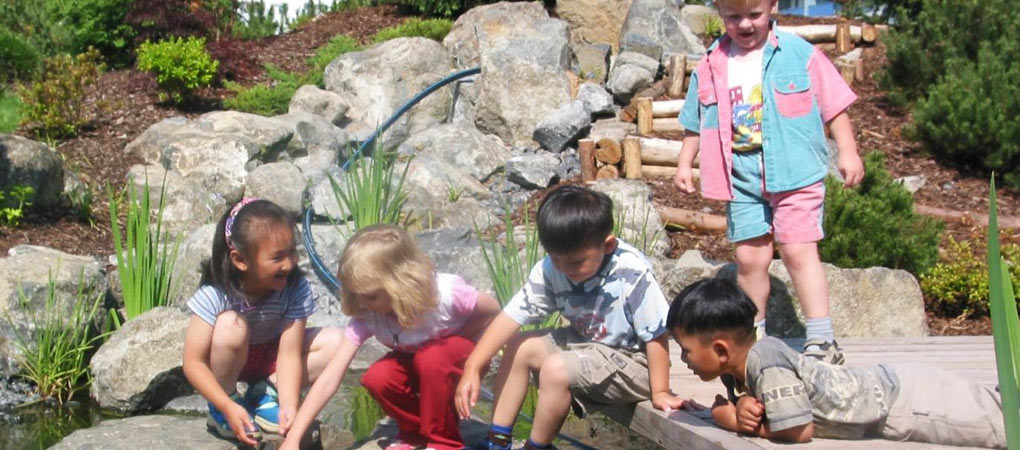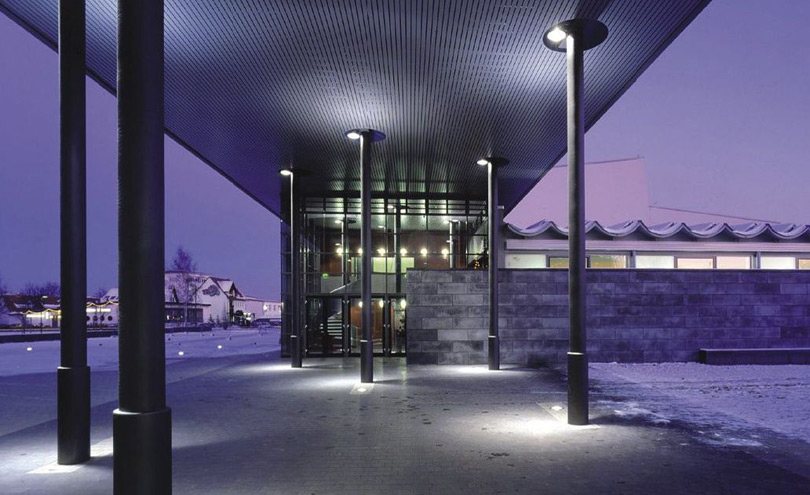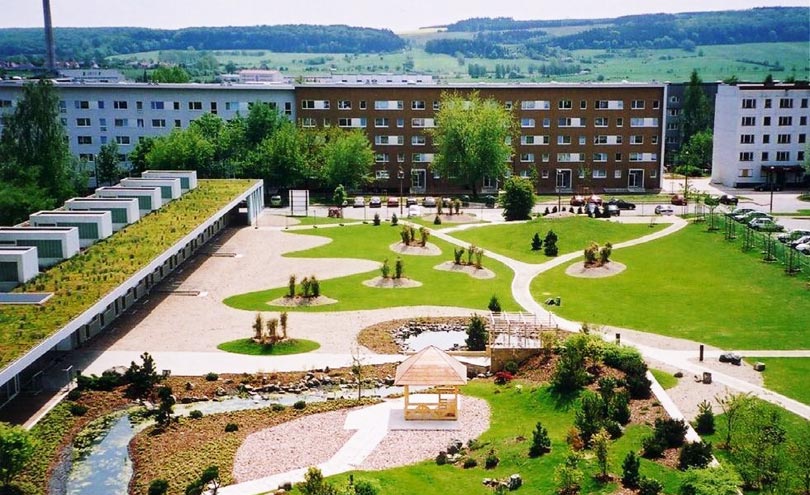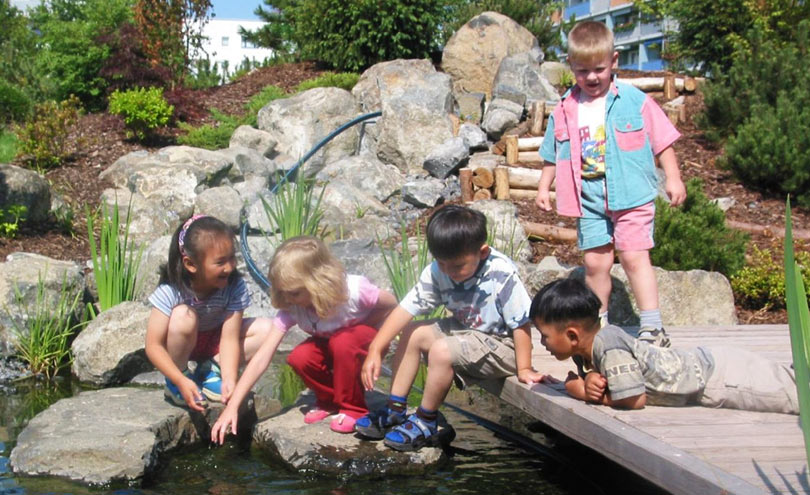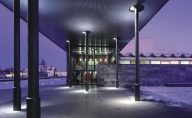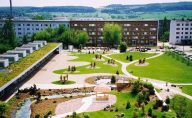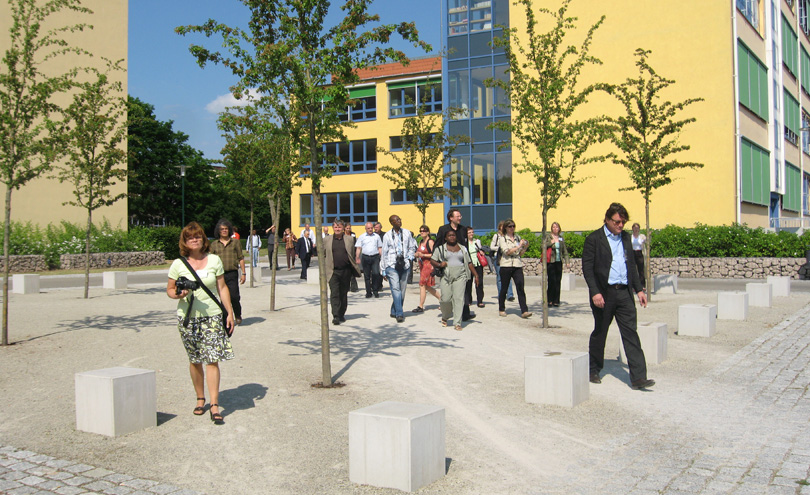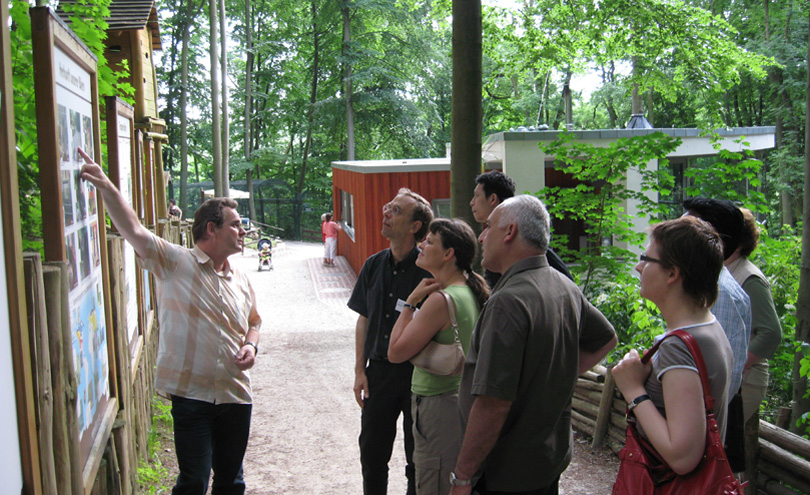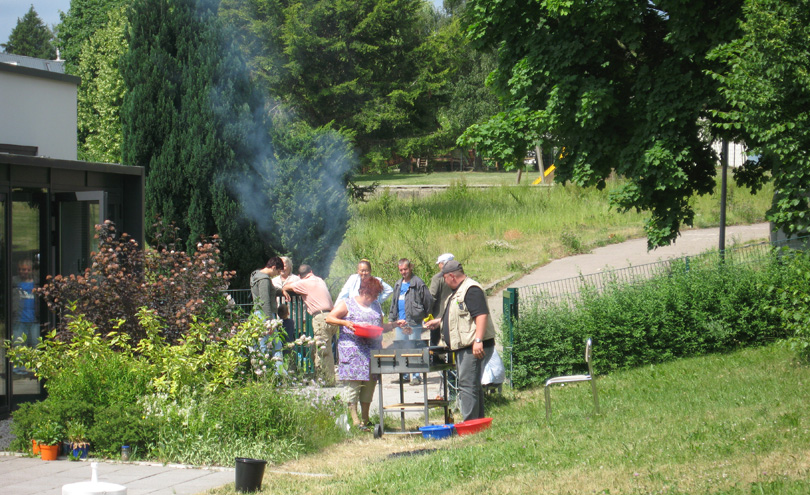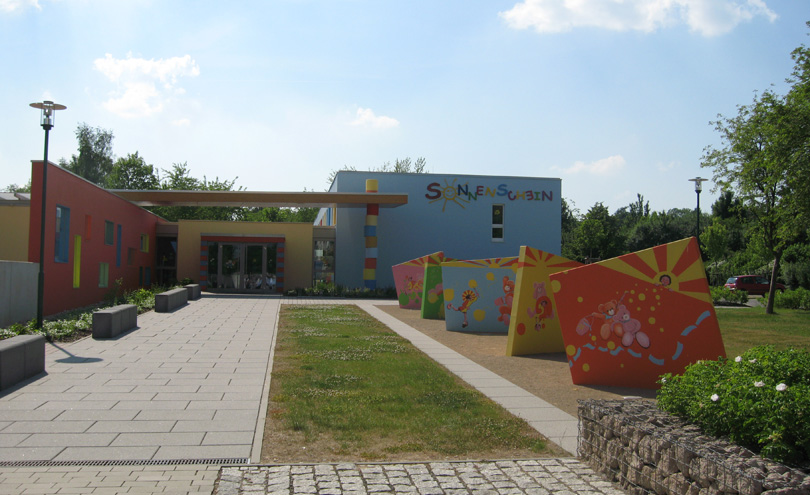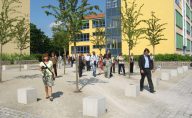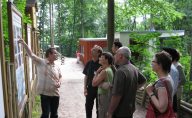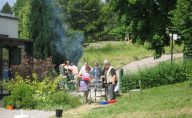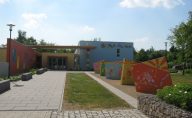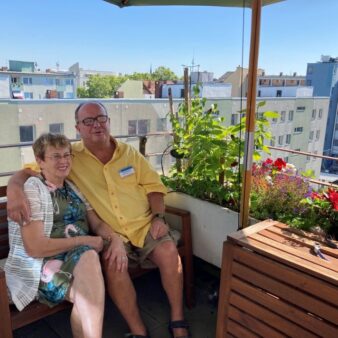Project Description
Aims and Objectives
The ‘ZukunftsWerkStadt’ project aims to achieve sustainable urban development in the context of the dramatic changes in eastern Germany after reunification. It consists of measures to:
- Dramatically improve living conditions, urban infrastructure and environments
- Create new job opportunities
- Promote affordable and attractive housing opportunities in a diversified and balanced housing market
- Improve social and economic stability and encourage active community life.
Project context
Located in the former East German region of Eichsfeld, the municipality of Leinefelde-Worbis has a population of approximately 20,000. The reunification of Germany in the 1990s fundamentally affected the small industrial town leading to the collapse of the textile industry and destroying its economic base.
With growing unemployment rates, many inhabitants left for other more prosperous regions in Germany, leaving their flats empty. The low-quality, standardised prefabricated units, which made up the bulk of the housing stock, were unappealing in the developing competitive housing market and those tenants with a higher income began to move out.
Demand for rental flats in the Südstadt district of Leinefelde fell to 50 per cent of the supply, with little or no economic possibilities for the remaining flats. In 2003, in order to harmonise development and to optimise communal infrastructures and administrative performance, the municipality of Leinefelde and that of the adjoining town, Worbis, joined forces to form the municipality of Leinefelde-Worbis.
Initiated by the municipality of Leinefelde-Worbis in response to these challenges, the ZukunftsWerkStadt’ project aims to achieve sustainable urban development in the transition from a planned to market economy. It consists of measures to create new job opportunities; improve living conditions, urban infrastructure and environments; promote affordable and attractive housing opportunities in a diversified and balanced housing market; improve social and economic stability and encourage active community life.
Sustainable urban development
From the outset, the project was conceived as an integrated urban development and regeneration strategy considering environmental, economic, social and organisational issues in combination.
The improved living conditions and resurgent local economy has created a base for social and financial stability. High quality public services and infrastructure including access to good schools, an efficient and convenient public transport system and facilities for sports and leisure pursuits have removed the primary reasons for tenant migration. The municipality’s integrated approach and work with private partners created essential conditions for sustainable private investment in the locality and the new urban environment is attracting new residents to the town.
A range of options were developed to deal with the various housing problems. Architectural competitions were held for all key projects and high environmental standards were applied throughout, whether for new construction, refurbishment or demolition of surplus apartments. The creation of employment has been a key aspect of the approach, as has the revitalisation of infrastructure, both physical and social.
The reorganisation of parking, building accesses and courtyards has improved the usability for residents of all ages. Various possibilities for sport and leisure provide occasions for encounters, communication and increased social integration.
Economic turnaround
The economic regeneration of Leineflede-Worbis has begun following the promotion of new enterprises with a diverse range of activities. The empty textile factory building has been subdivided and renovated to accommodate new businesses, and newly designated industrial areas offer further possibilities. Combining supportive regulatory processes and attractive locales has created a positive climate for new investment.
The project strategy has given residents, landlords, businesses and the municipality a positive economic outlook. The investment has been largely absorbed by the local building trade and the job market, at further advantage to the community. Leinefelde-Worbis currently hosts 1,200 businesses, and its unemployment figures of 8.3 per cent are significantly lower than the regional (Thuringia) average of 11.4 per cent. The municipal debt is a third lower than the regional average, despite its below-average per capita tax income. One thousand, three hundred people commute regularly into the town, and the six per cent increase in Sudstadt’s population in 2006 indicates that people are returning to the area.
The project has provided access to finance, training and assistance to unemployed residents. Specialist support and accessible jobs have been provided for recovering alcoholics and new jobs have been created through the building and development process.
Buildings
In accordance with the project’s integrated master Plan, 50 per cent of the housing has been demolished and the remaining stock refurbished. This has seen a significant increase in quality. Care was taken during the demolition and innovative techniques for dismantling were developed to ensure that as much of the prefabricated concrete slab constructions as possible could be reused in both construction and landscaping.
Building rubble is viewed not as waste but as a raw material: demolition, therefore, is a valuable source of reusable building materials. Lower transportation costs and the reduced need for raw materials, when combined with the improvement in building insulation and efficient technologies, have considerably reduced the housing stock’s energy consumption.
Density has been reduced and the urban space improved, opened up and revitalised. This has created space for private, semi-private and public use. Attention and investment has been given to strategically important public spaces, and this has proved a pre-condition for more intensive public life. The spatial anonymity of socialist urbanism has been replaced with clear distinctions between private and public spaces. Different housing types and sizes have been developed to encourage diversity and avoid the exclusion of low- or higher-income groups.
Covering costs
The US$180 million that has been invested in the project since 1993 has come from a range of sources, including local housing societies, local government and a national subsidy. Residents’ rental payments provide current and future revenue funding for the housing projects and an annual budget raised from taxes and subsidies ensure that the public space and public facilities are maintained.
The refurbished housing units are currently owned and rented out by the communal housing societies, although private ownership and access to private subsidies in the future remains an option. Vacant properties are so few in number that the housing societies have been able to consolidate and survive. The relationship between the communal housing societies and their residents has been a key factor in the success of the project. Intensive contact was initiated between the landlords and their tenants with specific schedules, plans and relocations decided jointly between them.
Impact
- The project has successfully slowed the decline in population, and the Südstadt district experienced a six per cent increase in 2006. Young people have found employment in Leinefelde, families with young children are taking advantage of the improved schooling and living environment, and elderly and retired people are utilising the improved local services.
- Over 1,700 apartments have been demolished, four years ahead of the project’s initial schedule.
- Two thousand, five hundred apartments have been refurbished, over 1,630 of them with private green spaces.
- The proportion of vacant apartments has been reduced to 10 per cent of the total, and only 3.5 per cent of the refurbished apartments are empty.
- All educational and social facilities have been refurbished or converted for other public uses.
- There are currently 1,200 businesses in Leinefelde-Worbis, contributing to the significant decrease in unemployment in comparison with the wider region.
Why is it innovative?
- Participatory process of planning, development and process of management.
- Sustainable urban development strategy for a shrinking town.
- Innovative ways of refurbishing standardised pre-fabricated housing units.
- Use of renewable energy and energy-efficiency measures.
- A new approach to spatial structure, including visual distinctions between public, semi-private and private space.
- Economical technologies for dismantling buildings and re-use of demolition materials in building and landscaping.
What is the environmental impact?
The project has re-used as much of the original building materials as possible. Selective dismantling techniques and technologies have been developed to exploit this resource efficiently, resulting in new ideas for affordable, sustainable procedures which minimise the consumption of energy and materials.
Examples of these techniques include:
- Maintenance of structural stability by installing temporary supports that still allowed the use of heavy machinery.
- The original construction sequence was carefully reversed.
- Motorised hammers were mounted on excavators for increased access to original welded components.
- New cutting techniques were developed to allow part of the slabs to be dismantled and to cut new openings in slabs.
The energy efficiency of all buildings was improved through:
- The use of renewable fuel and modern heating and distribution technologies.
- Thermal insulation of the walls has been improved through the use of polystyrene panels.
- Solar panels have been installed in pilot projects.
The mixed sewerage and rainwater drainage system maintains a sufficient self-cleaning capacity and has minimised the need for fresh water to flush the system.
The reduction in urban density has allowed local species of trees and other appropriate vegetation to be planted in public and private open spaces. The inhabitants perceive the ecological sustainability of the project as an important factor to their improved living conditions and consequently have developed a protective attitude towards the environment.
Pedestrian areas and cycle paths have been improved and social and commercial functions have been integrated into residential areas. This has reduced the use of motorised vehicles and encouraged the use of the City Bus.
Is it financially sustainable?
Since 1993, US$177 million has been invested in the project. This has come from a number of sources:
- US$102 million has been provided by housing societies
- US$41 million has been provided by the municipal government
- US$34 million has been provided by the administrative district
The double strategy of demolishing unwanted flats while simultaneously improving the quality and diversity of their housing stock has helped the housing societies to consolidate their financial position. Their early participation has allowed them to focus on refurbishment in core areas, avoiding unproductive investment in zones with no future potential.
Current and future revenue funding of the housing projects is provided through residents’ rent payments. The ratio of vacant to rented flats has been significantly reduced to below ten per cent of the total, and represents only 3.5 per cent of the refurbished stock, ensuring the economic survival and growth of the housing societies.
Much care was taken to ensure that the relationship between the landlords and the residents was as positive as possible, and the trust that developed is in part reflected by the high occupancy figures following the project. During the renovation process, simple refurbishment measures were carried out in some occupied apartments, with housing societies coordinating schedules with the tenants. Intensive refurbishment measures were carried out only on empty properties. No new leases were issued on buildings to be refurbished or demolished. Existing tenants were informed one to two years in advance, and could either move to an already refurbished apartment, or move temporarily to a refurbished apartment and return upon completion of the work. Costs for removal and furnishings were met by housing societies and most people chose to move only once.
The project has helped to stabilise the financial base of the municipality. The principal economic feature of the integrated approach is that it produces synergies between public and private investment. The mainly rural surrounding area is benefiting from the high quality of infrastructure, public facilities and urban environment provided by Leinefelde-Worbis, and this has a knock-on positive effect on the local economy.
What is the social impact?
The current regeneration of the area has begun restoring the pride of the inhabitants and has provided a stable social base following the dramatic changes and disruption that took place as a result of reunification. Participation in the process has been crucial and the municipality has looked for opportunities to engage and work with residents including:
- Exhibitions and public discussions.
- A regular free district newspaper.
- Installation of an information/service point in Südstadt that handled extensive demand during the early years of the project.
- Focussed workshops targeting specific project components (participants at the workshops included tenants, housing societies, municipality representatives, consultants and local interest groups).
- Activities to improve public spaces and community facilities.
- An annual Südstadt fair (since 2003).
- Support of intensive contact between landlords and tenants with specific schedules, plans and relocations decided jointly between housing societies and their tenants.
- The establishment of subject-specific working groups to engage tenants in the ongoing process.
Work has been done to integrate the immigrant families which make up between three and four per cent of the population in the project area. A Russian-speaking member of staff has provided assistance and special language classes have been offered by the Youth Centre.
The Social Services Centre has established a problem-solving network to work with social groups with problems such as alcoholism and debt. The ongoing training and capacity-building work has increased opportunities for the development of vocational skills. Combined with the increasing number of businesses basing themselves in Leinefelde-Worbis, this has reduced unemployment and eased the social tensions that lack of income can cause.
Barriers
- Mental barriers: after initial difficulties increasing awareness of population shrinkage, it took over two years to convince residents that less town can mean more quality. A pilot project for the refurbishment of a public square demonstrated what could be achieved. Involvement in the EXPO 2000 World Fair in Hanover, although initially ridiculed, resulted in enthusiastic dynamism. Convincing the inhabitants of the need to demolish the flats was also a challenged which was overcome through emphasis on the environmental qualities and possibilities if the project.
- Isolated interests: initially, different stakeholders acted only within their isolated interests. Participatory involvement in the processes of planning and implementation has created a new mutual understanding and a sense of solidarity.
- Limited margins of investment: funds are limited, and subsidy programmes only provide incremental support. Public funding changes every year. The master plan has been important in coordinating many small projects involving many stakeholders.
- Slowness of the process: a long-term transformation process was difficult for the inhabitants to accept, so many immediately tangible improvements were carried out as early as possible, creating a positive climate for change. Channels of communication were created between the public and the project to win acceptance and encourage participation.
- Technological deficits: the refurbishment process had to provide qualities unknown in socialist industrialised housing to enable it to compete on the open market. These include diverse housing types, adaptability, individualised floor plans, pleasant connections between indoor and outdoor spaces etc. the project has developed new solutions and new technologies for dismantling buildings, refurbishment and estate remodelling.
- Lack of awareness of quality: the housing societies and the inhabitants could not imagine the possibility or the value of adopting higher standards. Architectural competitions have proved a successful way to realise new ideas.
Lessons Learned
- A shrinking population offers new opportunities for quality improvements if the stakeholders act early enough and in a coordinated way.
- Isolated projects have only a limited impact and can waste money. The challenge is to achieve integrated and coordinated development. Investment must be concentrated on core areas with long-term perspectives.
- Stakeholder participation is a basic condition for feasibility and acceptance.
- Quality is a key to sustainability. Architectural competitions provide better solutions and innovation.
- Process management and quality control have to be continuous; this requires a continuity of objectives, organisational structures and key personnel.
- Informing the public in a transparent way creates the confidence and trust needed for cooperation and political stability.
Evaluation
Regular project monitoring using global quantitative indicators has confirmed the general strategy of the plan, and has helped to reveal where and how detailed adjustments should be incorporated. Two surveys analysing residents’ responses to the project confirmed a fundamental change in social attitude, perception of quality and the development of psychological attachment to the area. A new evaluation survey will be carried out in 2007.
Transfer
The Ministry of Urban Development and Housing in the State of Thuringia has often used Leinefelde as a reference or case study as it continuously works to improve the regulations and strategies for its urban development programmes.
The project contributed towards the launch of the Urban Reconstruction East 2002-2009 federal programme. An equivalent programme began in West Germany in 2006. The Bauhaus University Weimar offers a programme based on transferring the experiences of Leinefelde. Several main actors in the project have been recruited as teachers.
Participation in the EXPO 2000 world Fair in Hanover led to a number of international relationships, including intensive exchanges between Leinefelde-Worbis and Japanese and South Korean scientists, practising professionals and politicians. The project is repeatedly reviewed in Japanese architectural publications.
The Leinefelde-Worbis approach has been adapted and transferred to Algeria. Political reforms and new urban rehabilitation policies have been initiated to improve the conditions for participatory and sustainable upgrading processes.
Partnership
NGO, professional, national government, private sector

